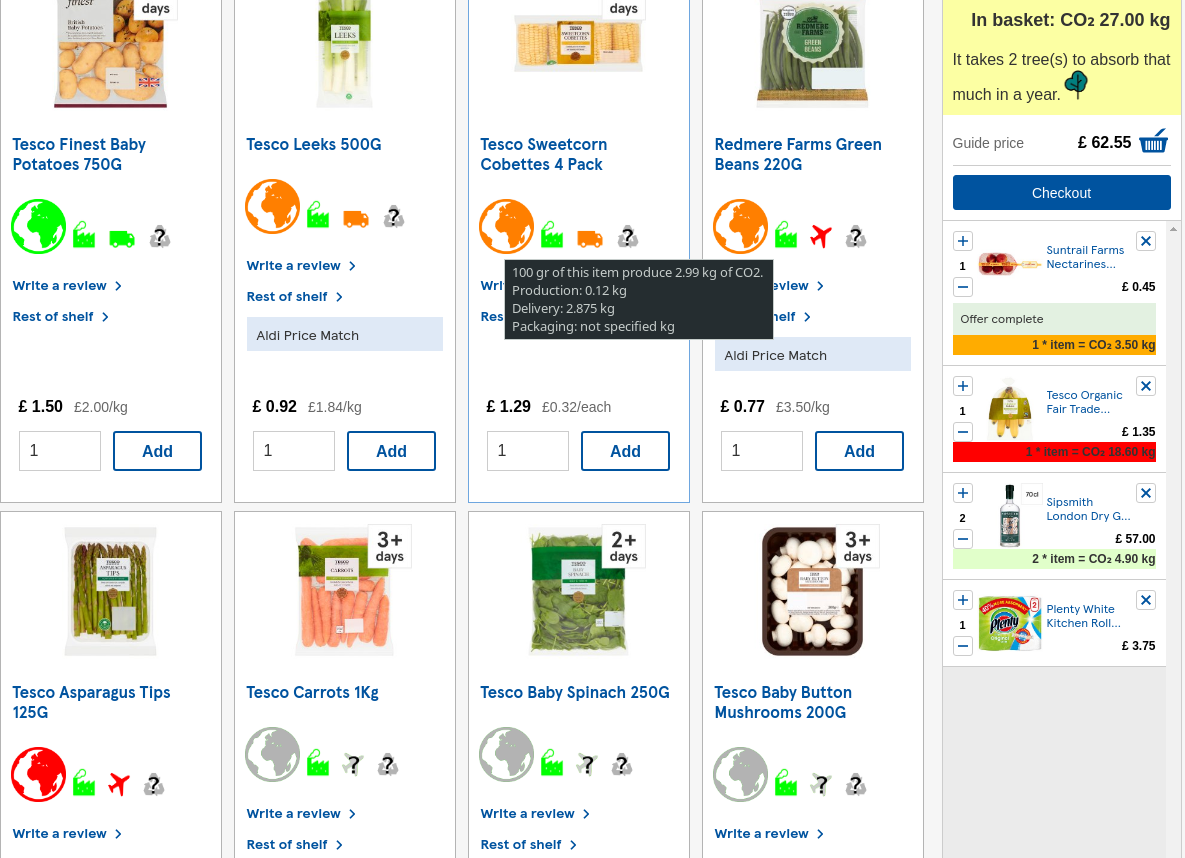Sustainable Food Interaction
The Problem
A third of global greenhouse gas (GHG) emissions are attributable to the food sector [1]. By the year 2050, it is estimated that the food sector will contribute to 50% of the affordable GHG emissions [2]. Educating consumers on the impact of their food consumption can be a powerful approach in tackling climate change. Education can help to reduce the use of natural resources and reduce a person’s total and the world’s global GHG emissions [1]. However, lacking relevant knowledge can be a significant barrier to buying eco-friendly foods [3]. Improving consumers’ understanding of the environmental impact of their food choices, and improving the availability and accessibility of environmental information for individual products,may help to close the "attitude behaviour gap" [4] that exists for consumers who are willing to purchase environmentally-friendly foods but whose intentions do not transform into actions.
Our Proposed Solution: Envirofy
We developed a browser extension called Envirofy (Figure 1). The tool was developed using the Behaviour Change Wheel [5]. Envirofy is the the first eco-friendly e-commerce grocery tool for real shoppers. Our research investigates behaviour change techniques during the point of purchase, during online shopping. The goal is to determine which behaviour intervention techniques are the most effective in supporting online shoppers to buy eco-friendly products.
Envirofy’s main components are:- Traffic light colour coded icons: under each product regarding the product’s total, production, transportation, and packaging performance. These can be compared across all food products.
- Restructuring the decision environment: the total environmental impact of a food item determines the display order on the current web page. Items with small totals are presented at the top of the page (green globes), and items with increasingly higher impacts are lower on the page (orange or red globes). The essence of such ’nudging’ approaches is to change environments in such a way that the better choice becomes a more convenient, attractive, or normal choice [6].
- Real time feedback: on the overall impact of the items currently in the users’ basket. This is displayed as CO2 and the number of trees that would be required planted to offset.
Impact
Preliminary results of pilot tests show that Envirofy significantly improves relevant knowledge, skills and perceived consumer effectiveness across all participants. Further, Envirofy significantly improves a consumer's overall environmental impact (i.e. carbon footprint per shop) - with up to 14% less CO2 in their shopping basket. If every online grocery shopper would utilise Envirofy, 4% of the UK’s annual GHG emissions will be saved, moving the UK closer to their net-zero goal.
The Behaviour Change Techniques investigated in this work do not only support the online shopper in making more environmentally friendly choices, but the resturcturing of the shopping environment (i.e. ordering food according to their CO2 impact) incentivises suppliers and the supply chain to procude more environmentally friendly products, if they want their products to appear at the top of the page.
Finally, the advantages of Envirofy are that it is easily extensible to any online supermarket (e.g. Tesco, Amazon, Shopify), and it has a huge potential for scaling up (e.g. fast fashion).
Future Work
In the future, we aim to:
- Investigate new Behaviour Change Techniques (BCT) such as goal setting [7], by contextualising CO2 values with a target CO2 per person;
- optimise the design of existing behaviour change techniques within Enviorfy, to enhance their effectiveness;
- extend Envirofy’s capabilities to more online retailers (e.g. Sainsbury’s); and
- extend Envirofy’s capabilities to the fast fashion sector (through the help of Save Your Wardrobe).
Funding
This research received £3000 funds from the EPSRC IAA account.Collaborators
- Laurence Webb, Tesco;
- Liam Walsh, WWF-UK;
- Pete Ritchie, Nourish Scotland; and
- Cat Hay, Food and Drink Federation Scotland.
References
[1] J. Poore and T. Nemecek. 2018.Reducing food’s environmental impacts through producersandconsumers.Science360,6392(2018),987–992.https://doi.org/10.1126/science.aaq0216arXiv:https://science.sciencemag.org/content/360/6392/987.full.pdf [2] Analysis and valuation of the health and climate change cobenefits of dietary change. Marco Springmann, H. Charles J. Godfray, Mike Rayner, and Peter Scarborough. PNAS first published March 21, 2016; https://doi.org/10.1073/pnas.1523119113 [3] Jennie I. Macdiarmid, Flora Douglas, and Jonina Campbell. 2016. Eating like there’s no tomorrow: Public awarenessof the environmental impact of food and reluctance to eat less meat as part of a sustainable diet.Appetite96 (2016),487 – 493. https://doi.org/10.1016/j.appet.2015.10.011 [4] Iris Vermeir and Wim Verbeke. 2006. Sustainable food consumption: Exploring the consumer “attitude–behavioralintention” gap. Journal of Agricultural and Environmental ethics 19, 2 (2006), 169–194 [5] Susan Michie, Maartje M Van Stralen, and Robert West. 2011. The behaviour change wheel: a new method forcharacterising and designing behaviour change interventions.Implementationscience 6, 1 (2011), 42. [6] Brian Wansink. 2015.Change Their Choice! Changing Behavior Using the CAN Approach and Ac-tivism Research.Psychology&Marketing32, 5 (2015), 486–500.https://doi.org/10.1002/mar.20794arXiv:https://onlinelibrary.wiley.com/doi/pdf/10.1002/mar.20794 [7] Mical Kay Shilts, Marcel Horowitz, and Marilyn S. Townsend. 2004. Goal Setting as a Strategy for Dietary and PhysicalActivity Behavior Change: A Review of the Literature.AmericanJournalofHealthPromotion19, 2 (2004), 81–93.https://doi.org/10.4278/0890-1171-19.2.81 arXiv:https://doi.org/10.4278/0890-1171-19.2.81 PMID: 15559708.

